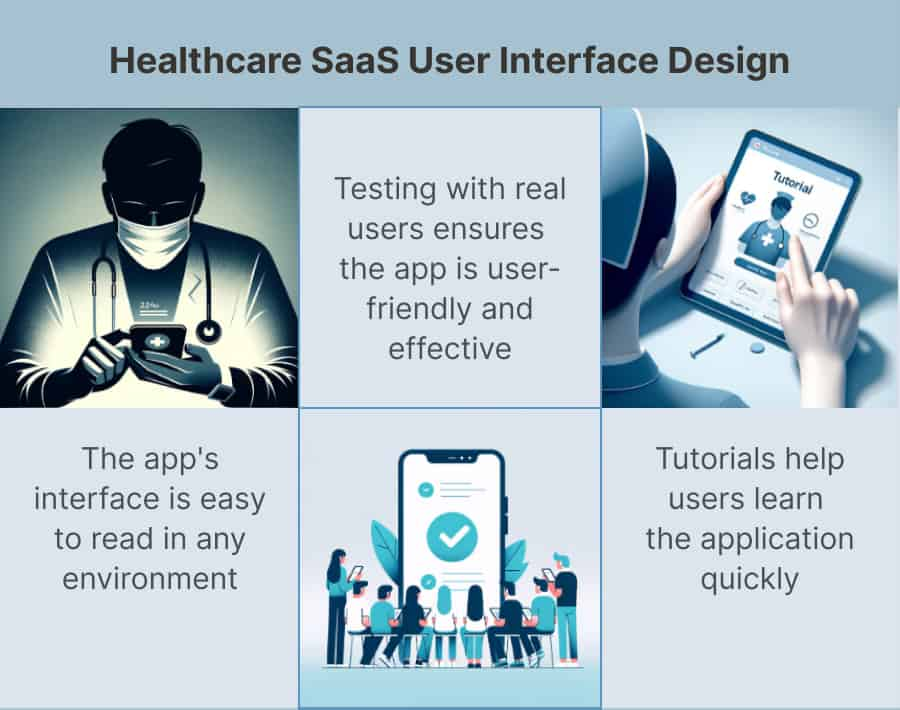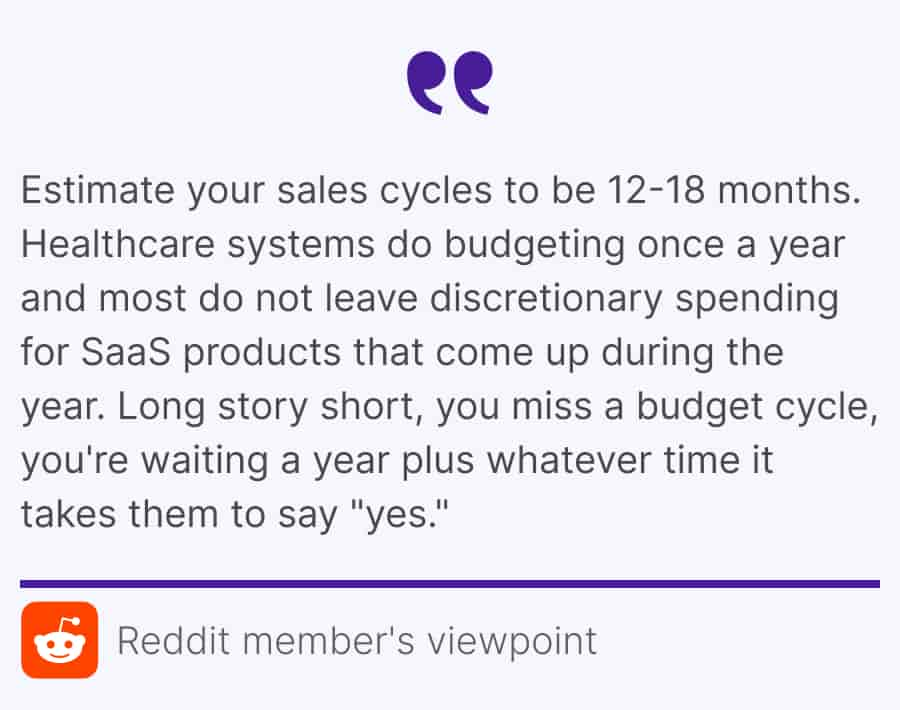Guide to Launching a Healthcare SaaS Startup in 2024
Topic: Guides

March 28, 2024
Healthcare is going digital at an explosive rate, presenting massive opportunities that entrepreneurs can seize:
- SaaS startup entrepreneurs are creating game-changing platforms like mobile electronic health records (EHR) systems for physicians to update from anywhere and artificial intelligence (AI) powered telemedicine apps for remote diagnosis.
- This shift to SaaS solves massive pain points - leaked efficiency from outdated processes, disconnected data silos, inconsistent patient experiences.
As an entrepreneur, you can seize this chance to build a SaaS product that streamlines healthcare logistics, elevates the quality of care, and improves lives.
However, the healthcare arena is a regulatory minefield to navigate. This guide is your map for charting that course successfully in 2024. We'll dive into market dynamics, choosing the right future-proof tech stack, designing intuitive UX for healthcare users, monetization strategies that create value, and complying with every regulation.
Get ready to blaze a trail - the time is now to launch your visionary healthcare SaaS idea.
Understanding the Market of the Healthcare SaaS in 2024
According to The Business Research Company, the global healthcare SaaS market size will swell from $20.96 billion in 2023 to $24.46 billion in 2024 at a staggering compound annual growth rate (CAGR) of 16.7%.

Market Trends and Predictions for 2024
Several key drivers are fueling this rapid expansion:
- Cost Efficiency and Scalability: Cloud-based SaaS models enable healthcare providers to optimize resources, reduce infrastructure costs, and quickly scale solutions as needs grow.
- Patient-Centric Focus: SaaS solutions empower a shift towards value-based, patient-centric care by enabling medical data integration, healthcare interoperability, and enhanced care coordination.
- Data Security: With stringent regulations like HIPAA, healthcare software vendors prioritize robust data security and privacy measures to safeguard sensitive patient information.
Looking ahead, the market will surge from $24.46 billion in 2024 to $48.78 billion by 2028 at an 18.8% CAGR. Key growth drivers include:
- Personalized medicine initiatives
- Continuous compliance management
- Enhanced interoperability standards
- Virtual clinical trials and research
- Mental health support solutions
This booming market presents vast opportunities for entrepreneurs to introduce disruptive SaaS solutions that address healthcare's most pressing challenges. But to thrive, you'll need a thorough understanding of the competitive landscape...
Competitor Analysis
The healthcare SaaS arena is a heated battlefield, where Goliath legacy systems clash with innovative David healthcare startups fighting for market dominance. Here's the lay of the land:
Heavyweight SaaS Companies in Healthcare:
- Epic Systems - Dominates the EHR/EMR space with solutions like EpicCare used by major hospitals and healthcare systems
- Cerner - Another leading EHR vendor popular among hospitals and clinics. Known for solutions like Cerner Millennium
- Athenahealth - Cloud-based suite covering EHR, revenue cycle, patient engagement and more
Emerging Startups:
- Omada Health - Virtual care platform focused on prevention and managing chronic conditions
- Bright.md - AI-powered virtual care automation for non-critical conditions
- K Health - Mobile app using AI for virtual triage, primary care and mental health
Other Streets Fighters:
- EHR/EMR: Veradigm, eClinicalWorks, NextGen Healthcare
- Telemedicine platforms: AmWell, Teladoc, MDLive
- Practice Management: DrChrono, Kareo, CareCloud
This landscape illustrates the diversity of cloud-based healthcare solutions and the fierce competition. Established giants have deep customer roots but can be slower movers. Startup companies bring innovative but often niche solutions.
To succeed, you'll need to carefully analyze incumbent strengths/weaknesses, identify underserved segments, and develop a differentiated value proposition. Whether displacing an existing player or creating a new category, you must solve key pain points better than rivals.
Target Audience Identification
Defining your target users is crucial before building a healthcare SaaS solution. You need to intimately understand their pains, challenges and what jobs they need your product to do.
Audience | Pain Points | Most Prominent Needs |
|---|---|---|
Healthcare Providers |
|
|
Healthcare Organizations |
|
|
Patients |
|
|
The opportunities are immense, but you must craft a laser-focused value proposition that scratches a high-value itch for a specific audience better than competitors. With a critically underserved need identified, you'll be armed to choose the right tech stack.

Choosing Technology Stack for Your Healthcare SaaS
In the healthcare sector, the choice of technology directly impacts your ability to deliver secure, compliant, and user-friendly solutions. Here’s what you need to know to make informed decisions alongside your development team.
Essential Components of a Healthcare Tech Stack
Front-end choices affect user experience.
- In healthcare, your users range from tech-savvy individuals to those with minimal digital literacy. Choose front-end technologies (like React or Angular) that are known for creating intuitive, accessible interfaces. This decision influences how easily users navigate your app, which is critical for wide adoption.
Back-end choices affect scalability and integration capabilities.
- Healthcare apps often need to manage sudden spikes in usage without compromising performance or security. Discuss with your team how well the chosen back-end tech (like Ruby or Python) can scale as your user base grows.
- Healthcare apps rarely work in isolation. They need to integrate with other systems like electronic health records (EHR), lab information systems (LIS), and more. Consider technologies that offer robust APIs and integration tools to simplify these connections.
Database decisions affect performance.
- Your app will deal with sensitive and complex data. Relational databases (like PostgreSQL) are traditionally used for their robustness in handling complex queries and transactions. However, if your app requires flexibility or deals with large volumes of unstructured data, NoSQL databases (like MongoDB) might be more appropriate.
Security and Compliance Technologies
For healthcare apps, compliance with data privacy laws like HIPAA and FDA regulations in the US or GDPR in Europe isn't optional - it's foundational.
- Your tech stack must support encryption, secure data storage, and other protections for patient data. Ask about technologies that have a track record of meeting these requirements.
- Beyond choosing secure technologies, ensure your team implements best practices for security in code development. This includes regular security audits, using secure coding practices, and staying updated on the latest in cybersecurity threats.
Navigating this regulatory landscape is crucial, as violations can result in hefty fines, legal repercussions, and irreparable reputational damage. However, this is a dense topic - refer to our dedicated compliance guide for comprehensive details on relevant healthcare laws.
Designing for the User
Let's talk about making your healthcare app something doctors, nurses and patients will actually love using day-in, day-out. Because even the most powerful features are useless if the experience feels clunky or complicated.
Principles of Healthcare UX/UI Design
Accessibility and Simplicity
When doctors are rushing between patients or nurses are triaging emergencies, a clunky, stressful interface is the last thing they need. Healthcare UX demands:
- Stripped-down layouts without distracting fluff
- Clean typography and intuitive iconography that communicates instantly
- Smart shortcuts for common actions like voice-capturing clinical notes
- Designing for real-world conditions like dimly-lit hospital hallways
- Full accessibility compliance so the app works flawlessly for users with disabilities
The core principle is relentless simplicity tailored to healthcare's demanding environments where users are under high cognitive load.
Engaging User Onboarding Experiences
Even the most intuitive interface needs some quick onboarding to unlock those "aha!" moments of immediate value. But we're not talking about endless training sessions. Nobody's got time for that.
It's much better to use interactive walkthroughs spotlighting key workflows the first time a doctor logs in. Or smart tooltips revealing timesaving shortcuts precisely when they're needed. We'll get users becoming worksheet warriors in your app immediately.
User Testing and Prototyping
Of course, we'll constantly refine and optimize based on real user feedback through:
- Usability testing - watching how actual doctors and nurses engage with prototypes
- Diary studies - having them document experiences using the app handling real patient scenarios
- Analytics - examining where user dropoff happens so we can eliminate frustrations
This iterative feedback cycle ensures your healthcare app feels laser-polished and tailored to its users' real needs and environments before it ever ships. We'll relentlessly polish the experience until it feels indispensable.

Developing a Sustainable Business Model
Let's talk revenue - because at the end of the day, your healthcare SaaS startup needs a money-making model that doesn't just bring in cash, but delivers value.
Monetization Strategies
- Subscriptions: Recurring monthly or annual fees for providers and healthcare organizations to access your platform are standard. But get creative with tiers for different features, user counts, etc.
- Freemium: The "try before you buy" approach. Give away a basic free version to hook users, while charging for premium capabilities like advanced reporting, priority support, etc. Works especially well for smaller practices.
- Value-Based Pricing: Rather than transactional fees, align pricing with measurable value delivered to clients. For example, pricing could be based on tangible cost savings or improved health outcomes enabled.
Avoid simplistic pricing that fails to capture the full impact of your solution. Identify a business model that yields recurring revenue while still providing a compelling ROI for cost-conscious healthcare customers operating on tight budgets.
Customer Acquisition and Retention
Bringing in new customers and keeping them for life is a multi-front marketing strategy.
Strategy | Description |
|---|---|
Content Marketing | Don't just sell - educate. Publish high-value guides, blogs, webinars that establish you as the trusted voice for your audience. |
Healthcare Events | Yeah, conferences and meetups are still a grind. But building face-to-face rapport is clutch for closing sales in this relationship-centric industry. |
Co-Marketing | Two brands are better than one. Join forces with complementary vendors on co-marketing and product integration plays. |
Customer Success | Ongoing training, proactive support, and strategic advisory aren't luxuries - they're the sustaining heartbeat for retention and expansion revenue. |
This is a marathon, not a sprint. Nurture relationships through customer-centric service relentlessly delivering ROI. That's how you build an enduring healthcare SaaS empire.

Conclusion
The healthcare SaaS landscape is still relatively nascent compared to other industries. However, it is poised for immense growth driven by rising demands for affordable, accessible, coordinated patient care. Emerging opportunities span AI-powered diagnostic tools, unified patient data platforms, Virtual Clinical Trials, and more.
Advice for Starting Healthcare SaaS Startups
While tempting to go it alone, the regulatory hurdles and technical complexities of healthcare SaaS make consulting experts extremely valuable. From architecting HIPAA-compliant data handling to navigating evolving interoperability standards - getting it wrong can derail your entire venture.
Partnering with a development team that has real-world experience building successful, compliant healthcare solutions can accelerate your time-to-market while mitigating risks. Their guidance identifies potential pitfalls upfront and ensures you build on secure foundations adhering to all relevant laws from the start.
Don't jeopardize your revolutionary healthcare SaaS idea by underestimating the regulatory challenges. Embrace outside expertise to make your vision a reality efficiently and compliantly.
Further Reading
- Software as a Service (SaaS) Market Size, Share & Industry Analysis by Fortune Business Insights
- Global Artificial Intelligence in Healthcare Market - Segment Analysis, Opportunity Assessment, Competitive Intelligence and Industry Outlook, 2016-2026 by All the Research
- The 3 Hottest Telehealth Stocks to Watch in 2024 - a review on InvestorPlace
- Nearly two-thirds of US consumers are mobile health app users - an article on Emarketer
- Emergence of Application-based Healthcare - an article on Patient Safety Network
- Most Popular Medical Android Apps: Ranking Analysis by SimilarWeb
- Healthcare SaaS: Whom to talk to? - a discussion on Reddit